Android 16 เปิดตัวฟีเจอร์และ API ใหม่ๆ ที่ยอดเยี่ยมสำหรับนักพัฒนาแอป ส่วนต่อไปนี้จะสรุปฟีเจอร์เหล่านี้เพื่อช่วยให้คุณเริ่มต้นใช้งาน API ที่เกี่ยวข้อง
ดูรายการ API ใหม่ แก้ไข และนําออกอย่างละเอียดได้ที่รายงานความแตกต่างของ API ดูรายละเอียดเกี่ยวกับ API ใหม่ได้ที่เอกสารอ้างอิง Android API โดยระบบจะไฮไลต์ API ใหม่เพื่อให้มองเห็นได้นอกจากนี้ คุณควรตรวจสอบส่วนต่างๆ ที่การเปลี่ยนแปลงแพลตฟอร์มอาจส่งผลต่อแอปของคุณด้วย ดูข้อมูลเพิ่มเติมได้ที่หน้าต่อไปนี้
- การเปลี่ยนแปลงลักษณะการทำงานที่ส่งผลต่อแอปเมื่อกำหนดเป้าหมายเป็น Android 16
- การเปลี่ยนแปลงลักษณะการทำงานที่ส่งผลต่อแอปทั้งหมดโดยไม่คำนึงถึง
targetSdkVersion
ฟังก์ชันหลัก
Android มี API ใหม่ที่ขยายความสามารถหลักของระบบ Android
Android API 2 รุ่นในปี 2025
- This preview is for the next major release of Android with a planned launch in Q2 of 2025. This release is similar to all of our API releases in the past, where we can have planned behavior changes that are often tied to a targetSdkVersion.
- We're planning the major release a quarter earlier (Q2 rather than Q3 in prior years) to better align with the schedule of device launches across our ecosystem, so more devices can get the major release of Android sooner. With the major release coming in Q2, you'll need to do your annual compatibility testing a few months earlier than in previous years to make sure your apps are ready.
- We plan to have another release in Q4 of 2025 which also will include new developer APIs. The Q2 major release will be the only release in 2025 to include planned behavior changes that could affect apps.
In addition to new developer APIs, the Q4 minor release will pick up feature updates, optimizations, and bug fixes; it will not include any app-impacting behavior changes.

We'll continue to have quarterly Android releases. The Q1 and Q3 updates in-between the API releases will provide incremental updates to help ensure continuous quality. We're actively working with our device partners to bring the Q2 release to as many devices as possible.
Using new APIs with major and minor releases
Guarding a code block with a check for API level is done today using
the SDK_INT constant with
VERSION_CODES. This will continue
to be supported for major Android releases.
if (SDK_INT >= VERSION_CODES.BAKLAVA) {
// Use APIs introduced in Android 16
}
The new SDK_INT_FULL
constant can be used for API checks against both major and minor versions with
the new VERSION_CODES_FULL
enumeration.
if (SDK_INT_FULL >= VERSION_CODES_FULL.[MAJOR or MINOR RELEASE]) {
// Use APIs introduced in a major or minor release
}
You can also use the
Build.getMinorSdkVersion()
method to get just the minor SDK version.
val minorSdkVersion = Build.getMinorSdkVersion(VERSION_CODES_FULL.BAKLAVA)
These APIs have not yet been finalized and are subject to change, so please send us feedback if you have any concerns.
ประสบการณ์ของผู้ใช้และ UI ของระบบ
Android 16 ช่วยให้นักพัฒนาแอปและผู้ใช้มีการควบคุมและความยืดหยุ่นมากขึ้นในการกำหนดค่าอุปกรณ์ให้เหมาะกับความต้องการ
การแจ้งเตือนที่เน้นความคืบหน้า
Android 16 เปิดตัวการแจ้งเตือนที่เน้นความคืบหน้าเพื่อช่วยผู้ใช้ติดตามเส้นทางตั้งแต่ต้นจนจบที่ผู้ใช้เป็นผู้เริ่มได้อย่างราบรื่น
Notification.ProgressStyle เป็นการแจ้งเตือนรูปแบบใหม่ที่ให้คุณสร้างการแจ้งเตือนที่เน้นความคืบหน้า กรณีการใช้งานหลัก ได้แก่ บริการร่วมเดินทาง การนำส่ง และการนำทาง ภายในNotification.ProgressStyle
คลาส คุณสามารถระบุสถานะและเหตุการณ์สำคัญในเส้นทางของผู้ใช้โดยใช้จุดและกลุ่ม
To learn more, see the Progress-centric notifications documentation page.
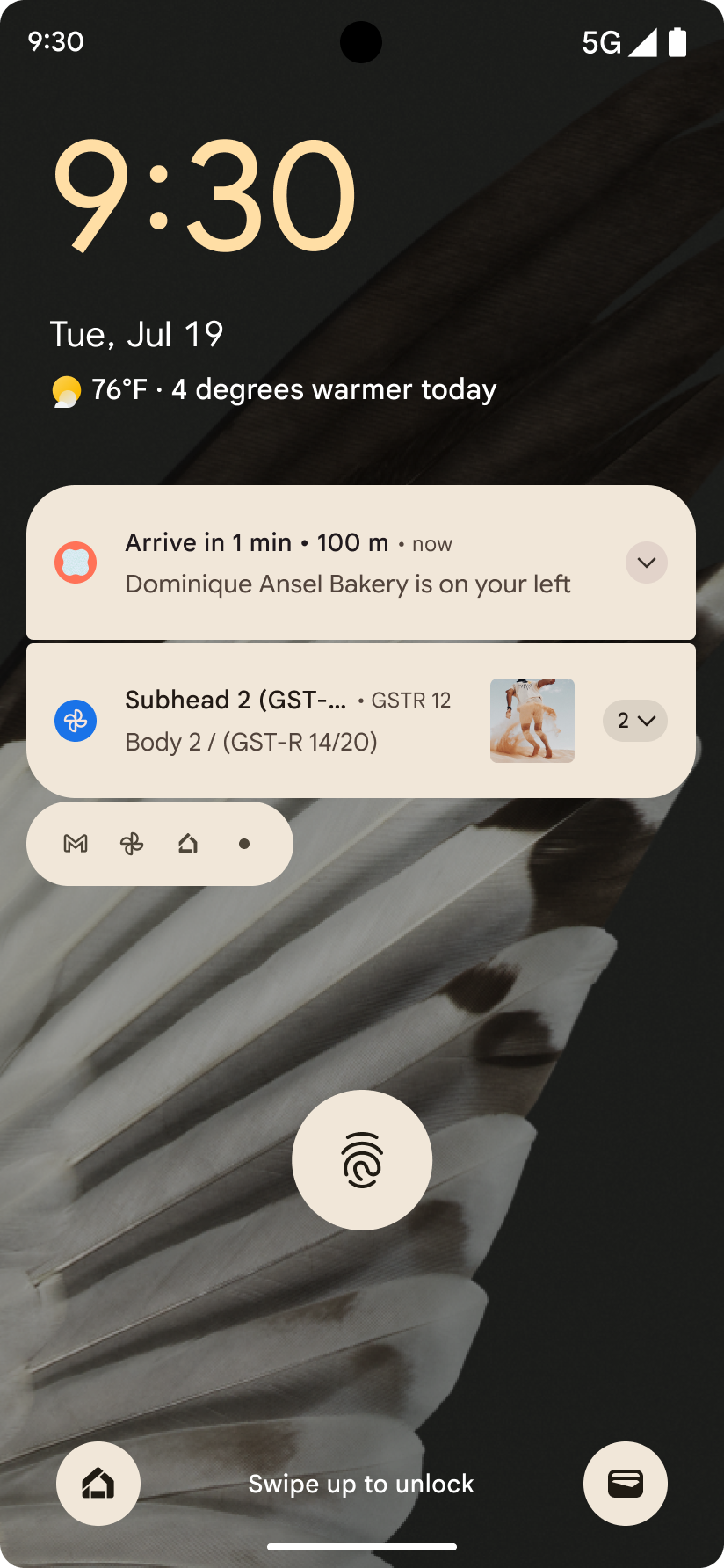

การอัปเดตการย้อนกลับที่คาดการณ์ได้
Android 16 adds new APIs to help you enable predictive back system animations in
gesture navigation such as the back-to-home animation. Registering the
onBackInvokedCallback with the new
PRIORITY_SYSTEM_NAVIGATION_OBSERVER allows your app to
receive the regular onBackInvoked call whenever the
system handles a back navigation without impacting the normal back navigation
flow.
Android 16 additionally adds the
finishAndRemoveTaskCallback() and
moveTaskToBackCallback. By registering these callbacks
with the OnBackInvokedDispatcher, the system can trigger
specific behaviors and play corresponding ahead-of-time animations when the back
gesture is invoked.
การโต้ตอบการสัมผัสที่ละเอียดยิ่งขึ้น
Android ได้เปิดการควบคุมตัวกระตุ้นการสัมผัสมาตั้งแต่เริ่มแรก
Android 11 เพิ่มการรองรับเอฟเฟกต์การสัมผัสที่ซับซ้อนมากขึ้นซึ่งตัวกระตุ้นขั้นสูงรองรับได้ผ่าน VibrationEffect.Compositions ของพรอมต์เชิงความหมายที่อุปกรณ์กำหนด
Android 16 เพิ่ม Haptic API ที่ช่วยแอปกำหนดความกว้างและความถี่ของเส้นโค้งของผลลัพธ์การสัมผัสได้ขณะที่แยกความแตกต่างระหว่างความสามารถของอุปกรณ์
เครื่องมือและประสิทธิภาพการทำงานของนักพัฒนาซอฟต์แวร์
แม้ว่างานส่วนใหญ่ของเราเพื่อปรับปรุงประสิทธิภาพการทำงานจะมุ่งเน้นไปที่เครื่องมือต่างๆ เช่น Android Studio, Jetpack Compose และไลบรารี Android Jetpack แต่เราก็มองหาวิธีต่างๆ ในแพลตฟอร์มเพื่อช่วยให้คุณสามารถบรรลุเป้าหมายได้เสมอ
การจัดการเนื้อหาสำหรับวอลเปเปอร์เคลื่อนไหว
In Android 16, the live wallpaper framework is gaining a new content API to
address the challenges of dynamic, user-driven wallpapers. Currently, live
wallpapers incorporating user-provided content require complex, service-specific
implementations. Android 16 introduces
WallpaperDescription and
WallpaperInstance. WallpaperDescription lets you
identify distinct instances of a live wallpaper from the same service. For
example, a wallpaper that has instances on both the home screen and on the lock
screen may have unique content in both places. The wallpaper picker and
WallpaperManager use this metadata to better present
wallpapers to users, streamlining the process for you to create diverse and
personalized live wallpaper experiences.
ประสิทธิภาพและแบตเตอรี่
Android 16 เปิดตัว API ที่ช่วยรวบรวมข้อมูลเชิงลึกเกี่ยวกับแอป
โปรไฟล์ที่ระบบทริกเกอร์
ProfilingManager was
added in Android 15, giving apps the ability to
request profiling data collection using Perfetto on public devices in the field.
However, since this profiling must be started from the app, critical flows such
as startups or ANRs would be difficult or impossible for apps to capture.
To help with this, Android 16 introduces system-triggered profiling to
ProfilingManager. Apps can register interest in receiving traces for certain
triggers such as cold start reportFullyDrawn
or ANRs, and then the system starts and stops a trace on the app's behalf. After
the trace completes, the results are delivered to the app's data directory.
เริ่มคอมโพเนนต์ใน ApplicationStartInfo
ApplicationStartInfo เพิ่มใน Android 15 ซึ่งช่วยให้แอปเห็นสาเหตุของการเริ่มกระบวนการ ประเภทการเริ่ม เวลาเริ่มต้น การจำกัด และข้อมูลการวินิจฉัยอื่นๆ ที่มีประโยชน์ Android 16 เพิ่ม getStartComponent() เพื่อแยกแยะประเภทคอมโพเนนต์ที่ทริกเกอร์การเริ่มต้น ซึ่งจะเป็นประโยชน์ในการเพิ่มประสิทธิภาพขั้นตอนการเริ่มต้นของแอป
การตรวจสอบงานที่ดียิ่งขึ้น
JobScheduler#getPendingJobReason() API จะแสดงเหตุผลที่งานอาจรอดำเนินการ อย่างไรก็ตาม งานอาจรอดำเนินการเนื่องจากหลายสาเหตุ
ใน Android 16 เราจะเปิดตัว API ใหม่ JobScheduler#getPendingJobReasons(int jobId) ซึ่งจะแสดงเหตุผลหลายประการที่งานรอดำเนินการอยู่ ทั้งข้อจำกัดที่นักพัฒนาแอปกำหนดไว้อย่างชัดเจนและข้อจำกัดโดยนัยที่ระบบกำหนดไว้
นอกจากนี้ เรายังเปิดตัว JobScheduler#getPendingJobReasonsHistory(int jobId) ซึ่งจะแสดงรายการการเปลี่ยนแปลงข้อจำกัดล่าสุด
เราขอแนะนำให้ใช้ API เพื่อช่วยแก้ไขข้อบกพร่องเกี่ยวกับสาเหตุที่งานอาจไม่ทํางาน โดยเฉพาะในกรณีที่อัตราความสําเร็จของงานบางอย่างลดลงหรือมีข้อบกพร่องเกี่ยวกับเวลาในการตอบสนองของงานที่เสร็จสมบูรณ์ เช่น การอัปเดตวิดเจ็ตในเบื้องหลังไม่สำเร็จ หรือเรียกใช้งานการเรียกข้อมูลล่วงหน้าก่อนการเริ่มแอปไม่สำเร็จ
นอกจากนี้ ยังช่วยให้คุณเข้าใจได้ดีขึ้นหากงานบางอย่างไม่เสร็จสมบูรณ์เนื่องจากข้อจำกัดที่ระบบกําหนดไว้เมื่อเทียบกับข้อจำกัดที่ตั้งไว้อย่างชัดเจน
อัตราการรีเฟรชแบบปรับอัตโนมัติ
Adaptive refresh rate (ARR), introduced in Android 15, enables the display refresh rate on supported hardware to adapt to the content frame rate using discrete VSync steps. This reduces power consumption while eliminating the need for potentially jank-inducing mode-switching.
Android 16 introduces hasArrSupport() and
getSuggestedFrameRate(int) while restoring
getSupportedRefreshRates() to make it easier for your apps to take
advantage of ARR. RecyclerView
1.4 internally supports ARR when it is settling from a fling or
smooth scroll, and we're continuing our work to add ARR
support into more Jetpack libraries. This frame rate article covers
many of the APIs you can use to set the frame rate so that your app can directly
use ARR.
Headroom API ใน ADPF
The SystemHealthManager introduces the
getCpuHeadroom and
getGpuHeadroom APIs, designed to provide games and
resource-intensive apps with estimates of available CPU and GPU resources. These
methods offer a way for you to gauge how your app or game can best improve
system health, particularly when used in conjunction with other Android Dynamic
Performance Framework (ADPF) APIs that detect thermal
throttling.
By using CpuHeadroomParams and
GpuHeadroomParams on supported devices, you can
customize the time window used to compute the headroom and select between
average or minimum resource availability. This can help you reduce your CPU or
GPU resource usage accordingly, leading to better user experiences and improved
battery life.
การช่วยเหลือพิเศษ
Android 16 เพิ่ม API และฟีเจอร์การช่วยเหลือพิเศษใหม่ๆ ที่ช่วยให้คุณนำเสนอแอปแก่ผู้ใช้ทุกคนได้
API การช่วยเหลือพิเศษที่ปรับปรุงแล้ว
Android 16 เพิ่ม API เพิ่มเติมเพื่อปรับปรุงความหมายของ UI ซึ่งจะช่วยเพิ่มความสอดคล้องสำหรับผู้ใช้ที่อาศัยบริการช่วยเหลือพิเศษ เช่น TalkBack
ขีดเส้นขอบข้อความเพื่อให้ข้อความมีความคมชัดสูงสุด
ผู้ใช้ที่มีความบกพร่องทางการมองเห็นมักมีความไวต่อคอนทราสต์ลดลง ทำให้แยกแยะวัตถุออกจากพื้นหลังได้ยาก Android 16 เปิดตัวข้อความขอบแทนที่ข้อความคอนทราสต์สูงเพื่อช่วยผู้ใช้เหล่านี้ ซึ่งจะวาดพื้นที่คอนทราสต์ขนาดใหญ่ขึ้นรอบข้อความเพื่อปรับปรุงความสามารถในการอ่านได้อย่างมาก
Android 16 มี API AccessibilityManager ใหม่เพื่อให้แอปตรวจสอบหรือลงทะเบียนโปรแกรมฟังเพื่อดูว่าเปิดใช้โหมดนี้หรือไม่ การดำเนินการนี้มีไว้สำหรับชุดเครื่องมือ UI เช่น Compose เป็นหลัก เพื่อมอบประสบการณ์การรับชมที่คล้ายกัน หากคุณดูแลรักษาไลบรารี UI Toolkit หรือแอปของคุณแสดงผลข้อความที่กำหนดเองซึ่งข้ามคลาส android.text.Layout คุณสามารถใช้แอตทริบิวต์นี้เพื่อดูว่าเปิดใช้ข้อความขอบหรือไม่

เพิ่มระยะเวลาลงใน TtsSpan
Android 16 ขยาย TtsSpan ด้วย TYPE_DURATION ซึ่งประกอบด้วย ARG_HOURS, ARG_MINUTES และ ARG_SECONDS ซึ่งจะช่วยให้คุณกำกับเวลาได้โดยตรง เพื่อให้เอาต์พุตการอ่านออกเสียงข้อความมีความแม่นยำและสอดคล้องกันกับบริการต่างๆ เช่น TalkBack
รองรับองค์ประกอบที่มีป้ายกำกับหลายรายการ
ปัจจุบัน Android อนุญาตให้องค์ประกอบ UI ดึงข้อมูลป้ายกำกับการช่วยเหลือพิเศษจากองค์ประกอบอื่น และตอนนี้สามารถเชื่อมโยงป้ายกำกับหลายรายการเข้าด้วยกันได้แล้ว ซึ่งเป็นสถานการณ์ที่พบได้ทั่วไปในเนื้อหาเว็บ การใช้ API ตามรายการภายใน AccessibilityNodeInfo จะช่วยให้ Android รองรับความสัมพันธ์แบบหลายป้ายกำกับเหล่านี้ได้โดยตรง การเปลี่ยนแปลงนี้ทำให้เราเลิกใช้งาน AccessibilityNodeInfo#setLabeledBy และ #getLabeledBy แล้วหันมาใช้ #addLabeledBy, #removeLabeledBy และ #getLabeledByList แทน
ปรับปรุงการรองรับองค์ประกอบแบบขยายได้
Android 16 เพิ่ม API การช่วยเหลือพิเศษที่ช่วยให้คุณสื่อสถานะแบบขยายหรือยุบขององค์ประกอบแบบอินเทอร์แอกทีฟ เช่น เมนูและรายการแบบขยายได้ การตั้งค่าสถานะแบบขยายโดยใช้ setExpandedState และการส่ง TYPE_WINDOW_CONTENT_CHANGED AccessibilityEvents ด้วยประเภทการเปลี่ยนแปลงเนื้อหา CONTENT_CHANGE_TYPE_EXPANDED จะช่วยให้มั่นใจได้ว่าโปรแกรมอ่านหน้าจออย่าง TalkBack จะประกาศการเปลี่ยนแปลงสถานะ ซึ่งมอบประสบการณ์การใช้งานที่ใช้งานง่ายและครอบคลุมมากขึ้นแก่ผู้ใช้
แถบความคืบหน้าที่ระบุสถานะไม่ได้
Android 16 เพิ่ม RANGE_TYPE_INDETERMINATE ซึ่งช่วยให้คุณแสดง RangeInfo สำหรับวิดเจ็ต ProgressBar ทั้งแบบกำหนดได้และแบบกำหนดไม่ได้ ซึ่งช่วยให้บริการอย่าง TalkBack แสดงความคิดเห็นสำหรับตัวบ่งชี้ความคืบหน้าได้อย่างสม่ำเสมอมากขึ้น
ช่องทำเครื่องหมายแบบ 3 สถานะ
ตอนนี้เมธอด AccessibilityNodeInfo
getChecked และ setChecked(int) แบบใหม่ใน Android 16 รองรับสถานะ "เลือกบางส่วน" นอกเหนือจาก "เลือก" และ "ยกเลิกการเลือก" แล้ว ซึ่งมาแทนที่บูลีน isChecked และ setChecked(boolean) ที่เลิกใช้งานแล้ว
คำอธิบายเพิ่มเติม
เมื่อบริการการช่วยเหลือพิเศษอธิบาย ViewGroup บริการจะรวมป้ายกำกับเนื้อหาจากมุมมองย่อย หากคุณระบุ contentDescription สำหรับ ViewGroup บริการการช่วยเหลือพิเศษจะถือว่าคุณลบล้างคำอธิบายของมุมมองย่อยที่โฟกัสไม่ได้ด้วย ซึ่งอาจทำให้เกิดปัญหาหากคุณต้องการติดป้ายกำกับรายการต่างๆ เช่น เมนูแบบเลื่อนลง (เช่น "ตระกูลแบบอักษร") ขณะเก็บค่าที่เลือกไว้ในปัจจุบันไว้สำหรับการช่วยเหลือพิเศษ (เช่น "Roboto") Android 16 เพิ่ม setSupplementalDescription เพื่อให้คุณระบุข้อความที่ให้ข้อมูลเกี่ยวกับ ViewGroup ได้โดยไม่ต้องลบล้างข้อมูลจากรายการย่อย
ฟิลด์ในแบบฟอร์มที่ต้องกรอก
Android 16 เพิ่ม setFieldRequired ลงใน AccessibilityNodeInfo เพื่อให้แอปบอกบริการการช่วยเหลือพิเศษได้ว่าต้องป้อนข้อมูลในช่องแบบฟอร์ม นี่เป็นสถานการณ์ที่สําคัญสําหรับผู้ใช้ที่กรอกแบบฟอร์มหลายประเภท แม้กระทั่งสิ่งง่ายๆ อย่างช่องทําเครื่องหมายข้อกําหนดและเงื่อนไขที่จําเป็น ซึ่งช่วยให้ผู้ใช้ระบุและไปยังช่องที่ต้องกรอกต่างๆ ได้อย่างรวดเร็วอย่างสม่ำเสมอ
ใช้โทรศัพท์เป็นอินพุตไมโครโฟนสำหรับการโทรด้วยเสียงด้วยเครื่องช่วยฟัง LEA
Android 16 adds the capability for users of LE Audio hearing aids to switch between the built-in microphones on the hearing aids and the microphone on their phone for voice calls. This can be helpful in noisy environments or other situations where the hearing aid's microphones might not perform well.
การควบคุมระดับเสียงรอบข้างสำหรับเครื่องช่วยฟัง LEA
Android 16 adds the capability for users of LE Audio hearing aids to adjust the volume of ambient sound that is picked up by the hearing aid's microphones. This can be helpful in situations where background noise is too loud or too quiet.
กล้อง
Android 16 เพิ่มการรองรับผู้ใช้กล้องมืออาชีพ ซึ่งช่วยให้ใช้การเปิดรับแสงอัตโนมัติแบบผสมผสานได้ พร้อมกับการปรับอุณหภูมิสีและการปรับสีที่แม่นยำ ตัวบ่งชี้โหมดกลางคืนแบบใหม่จะช่วยให้แอปทราบว่าควรเปลี่ยนจากหรือไปยังเซสชันกล้องโหมดกลางคืนเมื่อใด การดำเนินการ Intent ใหม่ช่วยให้คุณจับภาพเคลื่อนไหวได้ง่ายขึ้น และเราจะปรับปรุงรูปภาพ UltraHDR อย่างต่อเนื่องด้วยการรองรับการเข้ารหัส HEIC และพารามิเตอร์ใหม่จากมาตรฐานฉบับร่าง ISO 21496-1
การปรับการรับแสงอัตโนมัติแบบผสม
Android 16 เพิ่มโหมดการเปิดรับแสงอัตโนมัติแบบผสมใหม่ลงใน Camera2 ซึ่งช่วยให้คุณควบคุมแง่มุมต่างๆ ของการเปิดรับแสงด้วยตนเองได้ขณะที่อัลกอริทึมการเปิดรับแสงอัตโนมัติ (AE) จัดการส่วนที่เหลือ คุณสามารถควบคุมISO + AE และเวลาเปิดรับแสง + AE ซึ่งให้ความยืดหยุ่นมากกว่าแนวทางปัจจุบันที่คุณต้องควบคุมด้วยตนเองทั้งหมดหรือใช้การเปิดรับแสงอัตโนมัติทั้งหมด
public void setISOPriority() {
...
int[] availablePriorityModes =
mStaticInfo.getCharacteristics().get(CameraCharacteristics.
COLOR_AE_AVAILABLE_PRIORITY_MODES);
...
// Turn on AE mode to set priority mode
reqBuilder.set(CaptureRequest.CONTROL_AE_MODE,
CameraMetadata.CONTROL_AE_MODE_ON);
reqBuilder.set(CaptureRequest.CONTROL_AE_PRIORITY_MODE,
CameraMetadata.CONTROL_AE_PRIORITY_MODE_SENSOR_SENSITIVITY);
reqBuilder.set(CaptureRequest.SENSOR_SENSITIVITY,
TEST_SENSITIVITY_VALUE);
CaptureRequest request = reqBuilder.build();
...
}
การปรับอุณหภูมิสีและการปรับสีที่แม่นยำ
Android 16 adds camera support for fine color temperature and tint adjustments
to better support professional video recording applications. In previous Android
versions, you could control white balance settings through
CONTROL_AWB_MODE, which contains options limited to a
preset list, such as Incandescent,
Cloudy, and Twilight. The
COLOR_CORRECTION_MODE_CCT enables the use of
COLOR_CORRECTION_COLOR_TEMPERATURE and
COLOR_CORRECTION_COLOR_TINT for precise adjustments of
white balance based on the correlated color temperature.
fun setCCT() {
// ... (Your existing code before this point) ...
val colorTemperatureRange: Range<Int> =
mStaticInfo.characteristics[CameraCharacteristics.COLOR_CORRECTION_COLOR_TEMPERATURE_RANGE]
// Set to manual mode to enable CCT mode
reqBuilder[CaptureRequest.CONTROL_AWB_MODE] = CameraMetadata.CONTROL_AWB_MODE_OFF
reqBuilder[CaptureRequest.COLOR_CORRECTION_MODE] = CameraMetadata.COLOR_CORRECTION_MODE_CCT
reqBuilder[CaptureRequest.COLOR_CORRECTION_COLOR_TEMPERATURE] = 5000
reqBuilder[CaptureRequest.COLOR_CORRECTION_COLOR_TINT] = 30
val request: CaptureRequest = reqBuilder.build()
// ... (Your existing code after this point) ...
}
The following examples show how a photo would look after applying different color temperature and tint adjustments:
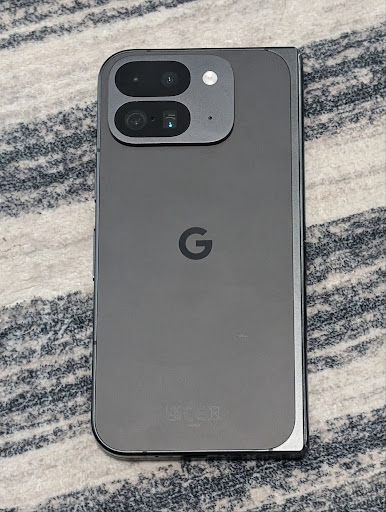
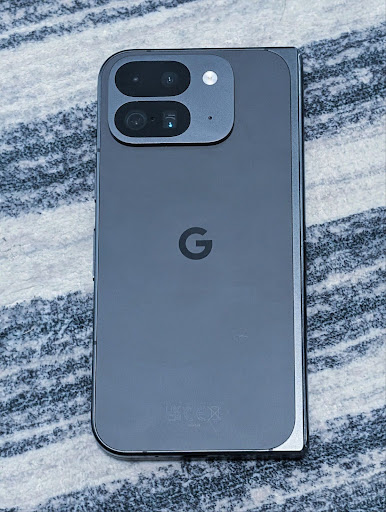
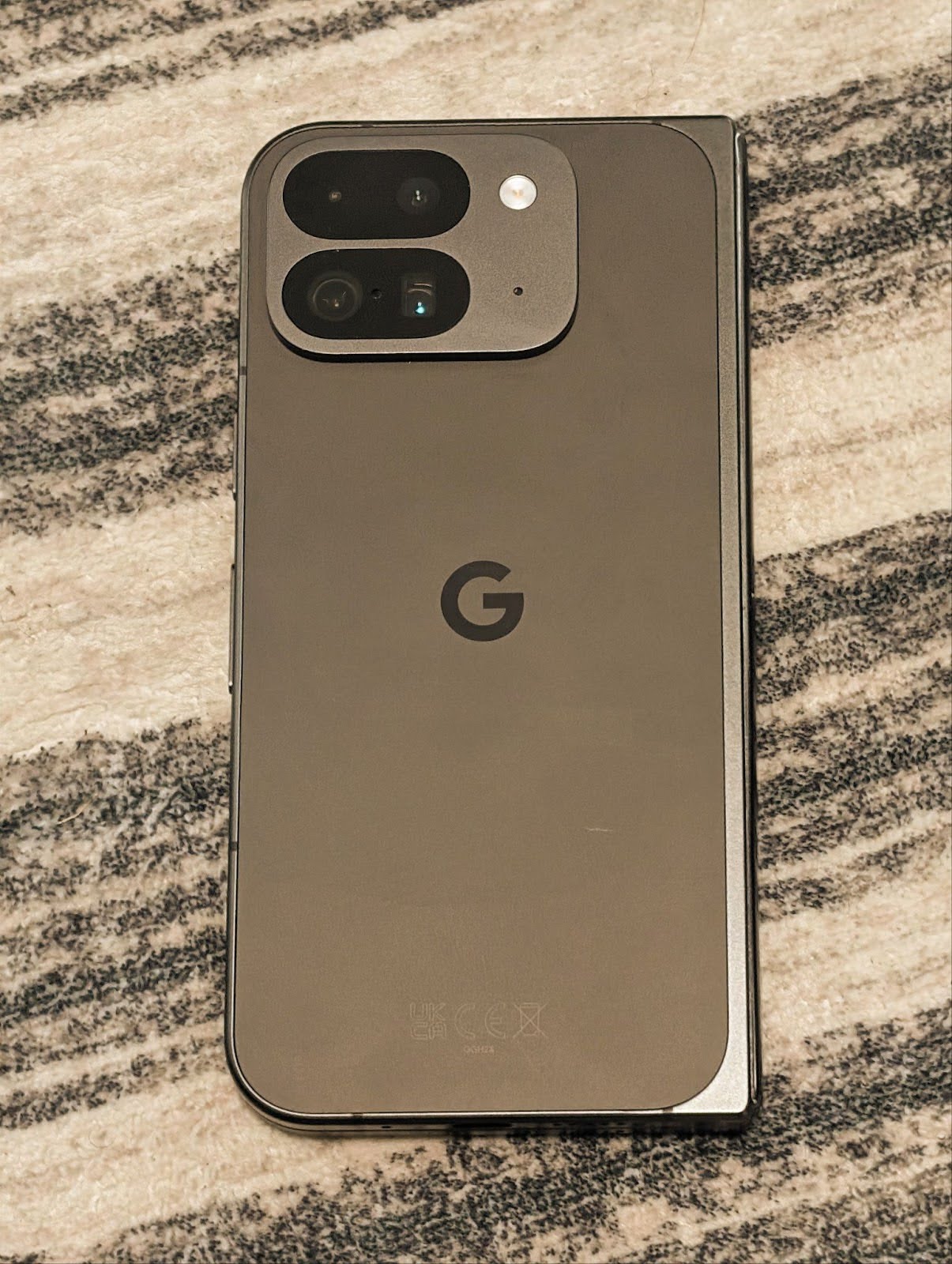

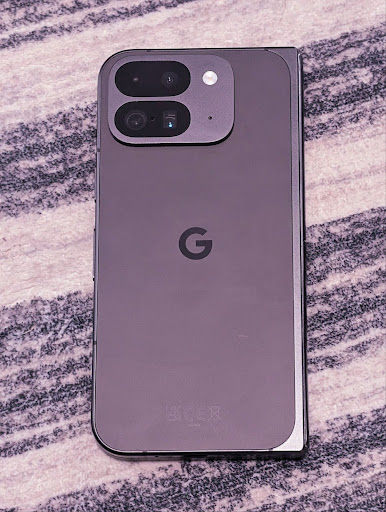
การตรวจจับฉากในโหมดกลางคืนของกล้อง
To help your app know when to switch to and from a night mode camera session,
Android 16 adds EXTENSION_NIGHT_MODE_INDICATOR. If
supported, it's available in the CaptureResult within
Camera2.
This is the API we briefly mentioned as coming soon in the How Instagram enabled users to take stunning low light photos blog post. That post is a practical guide on how to implement night mode together with a case study that links higher-quality in-app night mode photos with an increase in the number of photos shared from the in-app camera.
การดำเนินการผ่าน Intent สำหรับการจับภาพเคลื่อนไหว
Android 16 adds standard Intent actions —
ACTION_MOTION_PHOTO_CAPTURE, and
ACTION_MOTION_PHOTO_CAPTURE_SECURE — which request that
the camera application capture a motion photo and return
it.
You must either pass an extra EXTRA_OUTPUT to control
where the image will be written, or a Uri through
Intent.setClipData(ClipData). If you don't set a
ClipData, it will be copied there for you when calling
Context.startActivity(Intent).
การปรับปรุงรูปภาพด้วย UltraHDR
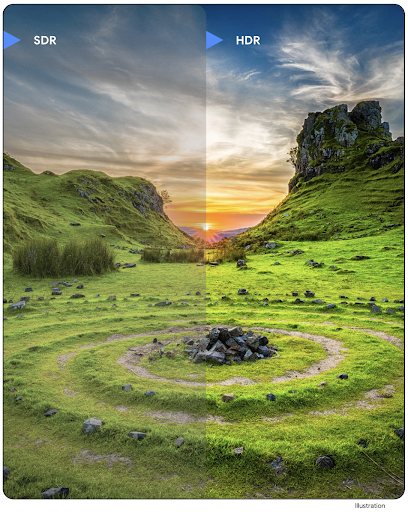
Android 16 continues our work to deliver dazzling image quality with UltraHDR
images. It adds support for UltraHDR images in the HEIC file
format. These images will get ImageFormat type
HEIC_ULTRAHDR and will contain an embedded gainmap similar
to the existing UltraHDR JPEG format. We're working on AVIF support for UltraHDR
as well, so stay tuned.
In addition, Android 16 implements additional parameters in UltraHDR from the ISO 21496-1 draft standard, including the ability to get and set the colorspace that gainmap math should be applied in, as well as support for HDR encoded base images with SDR gainmaps.
กราฟิก
Android 16 มีการปรับปรุงกราฟิกล่าสุด เช่น เอฟเฟกต์กราฟิกที่กำหนดเองด้วย AGSL
เอฟเฟกต์กราฟิกที่กำหนดเองด้วย AGSL
Android 16 adds RuntimeColorFilter and
RuntimeXfermode, allowing you to author complex effects like
Threshold, Sepia, and Hue Saturation and apply them to draw calls. Since Android
13, you've been able to use AGSL to create custom
RuntimeShaders that extend Shader. The new API
mirrors this, adding an AGSL-powered RuntimeColorFilter that
extends ColorFilter, and a Xfermode effect that
lets you implement AGSL-based custom compositing and blending between source and
destination pixels.
private val thresholdEffectString = """
uniform half threshold;
half4 main(half4 c) {
half luminosity = dot(c.rgb, half3(0.2126, 0.7152, 0.0722));
half bw = step(threshold, luminosity);
return bw.xxx1 * c.a;
}"""
fun setCustomColorFilter(paint: Paint) {
val filter = RuntimeColorFilter(thresholdEffectString)
filter.setFloatUniform(0.5);
paint.colorFilter = filter
}
การเชื่อมต่อ
Android 16 อัปเดตแพลตฟอร์มเพื่อให้แอปของคุณเข้าถึงเทคโนโลยีการสื่อสารและไร้สายที่ก้าวหน้าล่าสุด
การกำหนดช่วงที่มีประสิทธิภาพมากขึ้น
Android 16 เพิ่มการรองรับฟีเจอร์ด้านความปลอดภัยที่มีประสิทธิภาพในตำแหน่ง Wi-Fi บนอุปกรณ์ที่รองรับ 802.11az ของ Wi-Fi 6 ซึ่งช่วยให้แอปสามารถรวมความแม่นยำที่สูงขึ้น ความสามารถในการปรับขนาดที่มากขึ้น และการกําหนดเวลาแบบไดนามิกของโปรโตคอลเข้ากับการปรับปรุงด้านความปลอดภัย ซึ่งรวมถึงการเข้ารหัสตาม AES-256 และการป้องกันการโจมตี MITM ซึ่งช่วยให้ใช้งานได้อย่างปลอดภัยมากขึ้นใน Use Case ต่างๆ ในระยะใกล้ เช่น ปลดล็อกแล็ปท็อปหรือประตูรถยนต์ 802.11az ผสานรวมกับมาตรฐาน Wi-Fi 6 เพื่อใช้ประโยชน์จากโครงสร้างพื้นฐานและความสามารถของมาตรฐานนี้เพื่อการใช้งานในวงกว้างขึ้นและการติดตั้งใช้งานได้ง่ายขึ้น
API การจัดประเภททั่วไป
Android 16 includes the new RangingManager, which provides
ways to determine the distance and angle on supported hardware between the local
device and a remote device. RangingManager supports the usage of a variety of
ranging technologies such as BLE channel sounding, BLE RSSI-based ranging, Ultra
Wideband, and Wi-Fi round trip time.
สื่อ
Android 16 มีฟีเจอร์มากมายที่ช่วยปรับปรุงประสบการณ์การใช้งานสื่อ
การปรับปรุงเครื่องมือเลือกรูปภาพ
The photo picker provides a safe, built-in way for users to grant your app access to selected images and videos from both local and cloud storage, instead of their entire media library. Using a combination of Modular System Components through Google System Updates and Google Play services, it's supported back to Android 4.4 (API level 19). Integration requires just a few lines of code with the associated Android Jetpack library.
Android 16 includes the following improvements to the photo picker:
- Embedded photo picker: New APIs that enable apps to embed the photo picker into their view hierarchy. This allows it to feel like a more integrated part of the app while still leveraging the process isolation that allows users to select media without the app needing overly broad permissions. To maximize compatibility across platform versions and simplify your integration, you'll want to use the forthcoming Android Jetpack library if you want to integrate the embedded photo picker.
- Cloud search in photo picker: New APIs that enable searching from the cloud media provider for the Android photo picker. Search functionality in the photo picker is coming soon.
วิดีโอขั้นสูงสำหรับมืออาชีพ
Android 16 introduces support for the Advanced Professional Video (APV) codec which is designed to be used for professional level high quality video recording and post production.
The APV codec standard has the following features:
- Perceptually lossless video quality (close to raw video quality)
- Low complexity and high throughput intra-frame-only coding (without pixel domain prediction) to better support editing workflows
- Support for high bit-rate range up to a few Gbps for 2K, 4K and 8K resolution content, enabled by a lightweight entropy coding scheme
- Frame tiling for immersive content and for enabling parallel encoding and decoding
- Support for various chroma sampling formats and bit-depths
- Support for multiple decoding and re-encoding without severe visual quality degradation
- Support multi-view video and auxiliary video like depth, alpha, and preview
- Support for HDR10/10+ and user-defined metadata
A reference implementation of APV is provided through the OpenAPV project. Android 16 will implement support for the APV 422-10 Profile that provides YUV 422 color sampling along with 10-bit encoding and for target bitrates of up to 2Gbps.
ความเป็นส่วนตัว
Android 16 มีฟีเจอร์มากมายที่ช่วยให้นักพัฒนาแอปปกป้องความเป็นส่วนตัวของผู้ใช้
การอัปเดต Health Connect
Health Connect ในเวอร์ชันตัวอย่างสำหรับนักพัฒนาแอปจะเพิ่มACTIVITY_INTENSITY ซึ่งเป็นประเภทข้อมูลใหม่ที่กําหนดตามหลักเกณฑ์ขององค์การอนามัยโลกเกี่ยวกับกิจกรรมระดับปานกลางและหนัก แต่ละระเบียนต้องมีเวลาเริ่มต้น เวลาสิ้นสุด และระดับความเข้มข้นของกิจกรรมว่าปานกลางหรือหนัก
นอกจากนี้ Health Connect ยังมี API ที่อัปเดตซึ่งรองรับบันทึกข้อมูลสุขภาพด้วย ซึ่งจะช่วยให้แอปอ่านและเขียนเวชระเบียนในรูปแบบ FHIR ได้โดยได้รับความยินยอมจากผู้ใช้อย่างชัดเจน API นี้อยู่ในโปรแกรมทดลองใช้ก่อนเปิดตัว หากต้องการเข้าร่วม โปรดลงชื่อสมัครเข้าร่วมโปรแกรมทดลองใช้ก่อนเปิดตัว
Privacy Sandbox ใน Android
Android 16 incorporates the latest version of the Privacy Sandbox on Android, part of our ongoing work to develop technologies where users know their privacy is protected. Our website has more about the Privacy Sandbox on Android developer beta program to help you get started. Check out the SDK Runtime which allows SDKs to run in a dedicated runtime environment separate from the app they are serving, providing stronger safeguards around user data collection and sharing.
ความปลอดภัย
Android 16 มีฟีเจอร์ที่ช่วยเพิ่มความปลอดภัยของแอปและปกป้องข้อมูลของแอป
Key Sharing API
Android 16 เพิ่ม API ที่รองรับการแชร์สิทธิ์เข้าถึงคีย์ใน Android Keystore กับแอปอื่นๆ คลาส KeyStoreManager ใหม่รองรับการให้และเพิกถอนสิทธิ์เข้าถึงคีย์ตาม uid ของแอป และมี API สําหรับแอปในการเข้าถึงคีย์ที่แชร์
รูปแบบของอุปกรณ์
Android 16 รองรับแอปเพื่อให้คุณได้รับประโยชน์สูงสุดจากรูปแบบของ Android
กรอบคุณภาพของภาพและเสียงที่เป็นมาตรฐานสำหรับทีวี
The new MediaQuality
package in Android 16 exposes
a set of standardized APIs for access to audio and picture profiles and
hardware-related settings. This allows streaming apps to query profiles and
apply them to media dynamically:
- Movies mastered with a wider dynamic range require greater color accuracy to see subtle details in shadows and adjust to ambient light, so a profile that prefers color accuracy over brightness may be appropriate.
- Live sporting events are often mastered with a narrow dynamic range, but are often watched in daylight, so a profile that preferences brightness over color accuracy can give better results.
- Fully interactive content wants minimal processing to reduce latency, and wants higher frame rates, which is why many TV's ship with a game profile.
The API allows apps to switch between profiles and users to enjoy tuning supported TVs to best suit their content.
การทำให้เป็นสากล
Android 16 เพิ่มฟีเจอร์และความสามารถที่เสริมประสบการณ์ของผู้ใช้เมื่อใช้อุปกรณ์ในภาษาต่างๆ
ข้อความแนวตั้ง
Android 16 adds low-level support for rendering and measuring text vertically to
provide foundational vertical writing support for library developers. This is
particularly useful for languages like Japanese that commonly use vertical
writing systems. A new flag,
VERTICAL_TEXT_FLAG,
has been added to the Paint class. When
this flag is set using
Paint.setFlags, Paint's
text measurement APIs will report vertical advances instead of horizontal
advances, and Canvas will draw text
vertically.
val text = "「春は、曙。」"
Box(
Modifier.padding(innerPadding).background(Color.White).fillMaxSize().drawWithContent {
drawIntoCanvas { canvas ->
val paint = Paint().apply { textSize = 64.sp.toPx() }
// Draw text vertically
paint.flags = paint.flags or VERTICAL_TEXT_FLAG
val height = paint.measureText(text)
canvas.nativeCanvas.drawText(
text,
0,
text.length,
size.width / 2,
(size.height - height) / 2,
paint
)
}
}
) {}
การปรับแต่งระบบการวัด
Users can now customize their measurement system in regional preferences within
Settings. The user preference is included as part of the locale code, so you can
register a BroadcastReceiver on
ACTION_LOCALE_CHANGED to handle locale configuration changes when
regional preferences change.
Using formatters can help match the local experience. For example, "0.5 in" in English (United States), is "12,7 mm" for a user who has set their phone to English (Denmark) or who uses their phone in English (United States) with the metric system as the measurement system preference.
To find these settings, open the Settings app and navigate to System > Languages & region.

